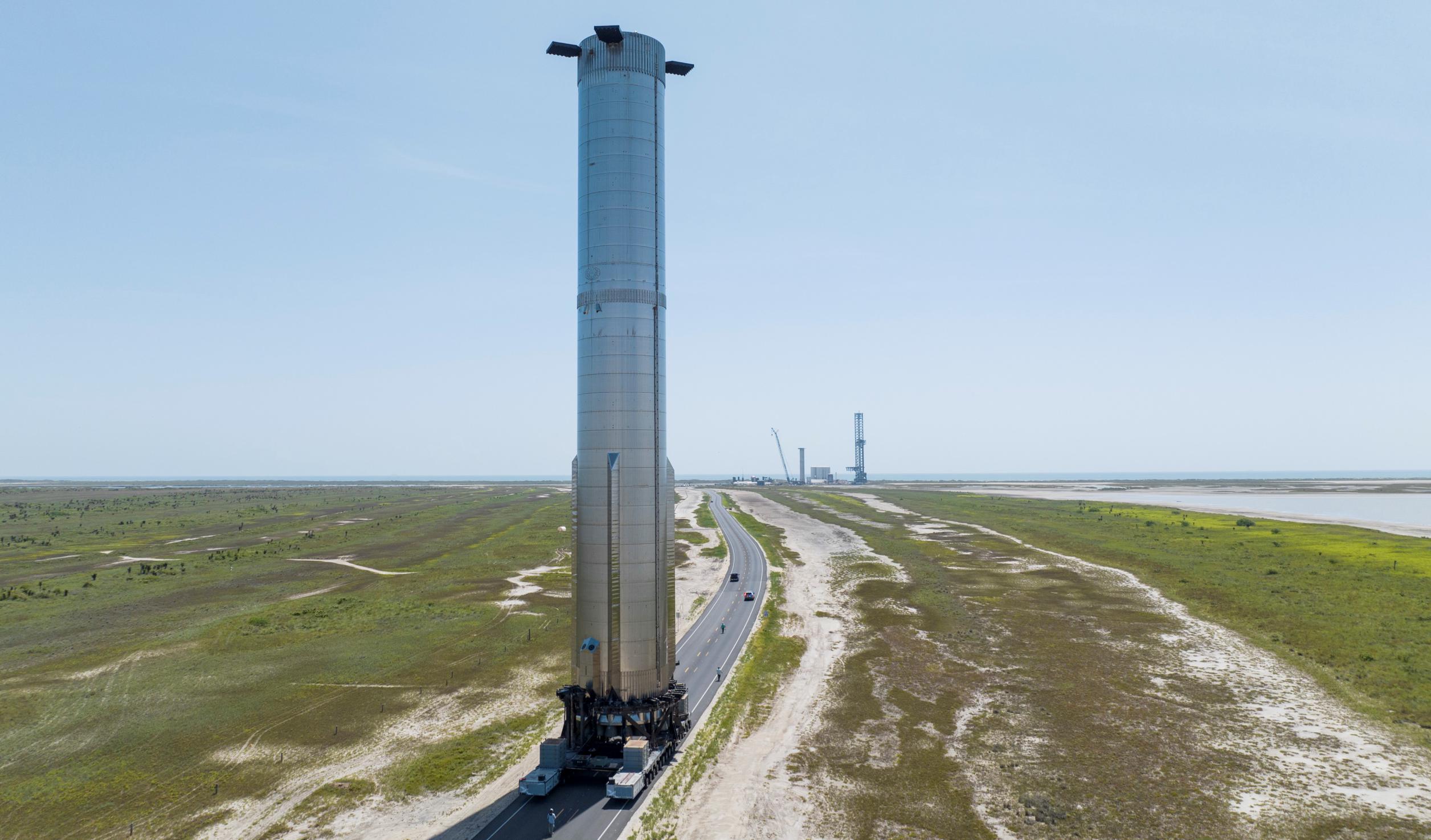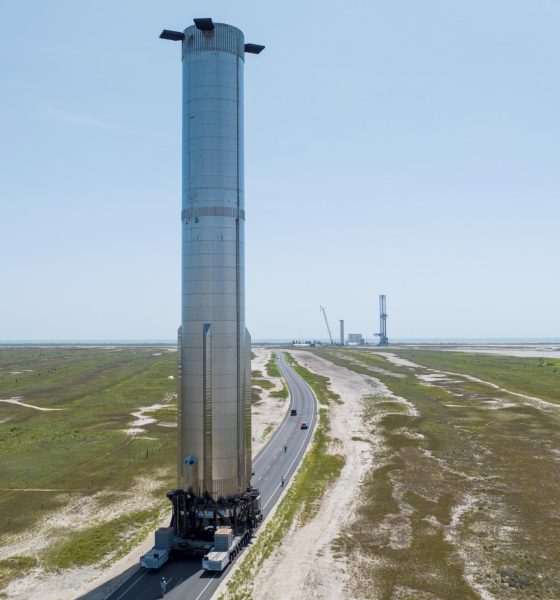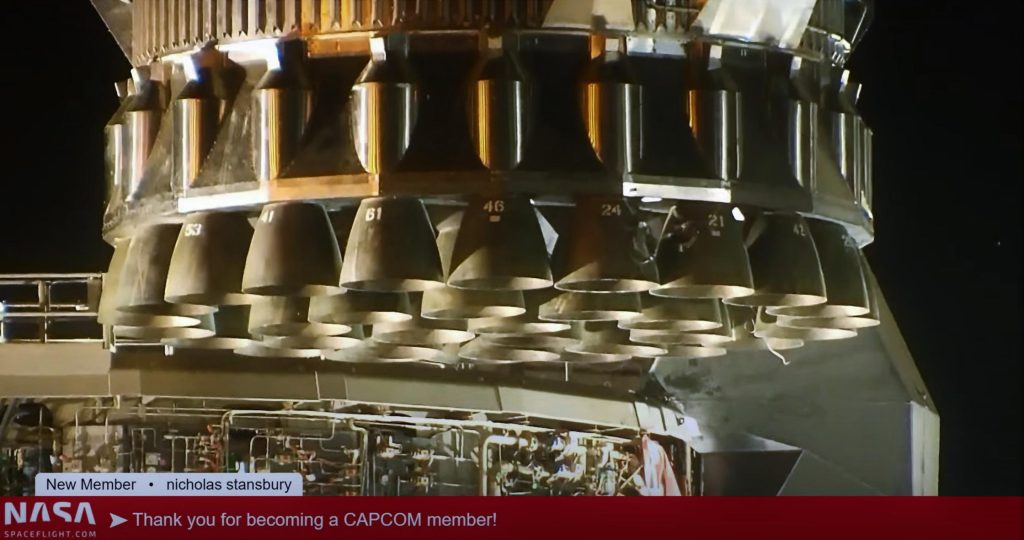

News
SpaceX installs Super Heavy booster on launch mount with giant robot arms
SpaceX has transported the most powerful rocket booster ever assembled to its Starbase orbital launch site (OLS) and used giant robotic arms to install it.
It’s not the first such trip for Starship’s Super Heavy first stage in general, nor for this specific booster, which is known as Booster 7 or B7. Booster 7 first headed to the pad on March 31st and successfully completed two major cryogenic proof tests, but was then severely damaged during a subsequent structural stress test. After a few weeks of repairs back at the factory, B7 rolled to the pad a second time and completed a third cryoproof test and returned to the factory on May 14th, where it stayed until June 23rd.
After almost six weeks of additional work, Booster 7 rolled to the launch pad for the third time – possibly its last trip.
Even Booster 7’s first rollout wasn’t unprecedented, however. In September 2021, Booster 4 – an earlier prototype with fewer engines, less thrust, and several other differences – arrived at the launch site with 29 Raptor V1 engines installed. Over the next six months, SpaceX slowly finished the booster, conducted a handful of proof tests, and eventually performed three ‘full-stack’ tests with Starship S20. For awhile, SpaceX hoped to eventually fly B4 and S20 on Starship’s first orbital launch attempt, but that plan never came close to fruition.
Booster 4 was particularly underwhelming and never even attempted a single static fire despite having all 29 of its engines fully installed and encased inside a shell-like heat shield. Thankfully, Booster 7 appears to have a much better chance of at least attempting one or several static fires, even if there’s no guarantee that it will make it through that test campaign in good enough condition to support Starship’s orbital launch debut.
SpaceX used the six weeks Booster 7 spent back in a factory assembly bay to finish installing aerocovers, surfaces known as chines or strakes, car-sized grid fins, Starlink internet dishes, and – most importantly – 33 upgraded Raptor V2 engines. Combined, Booster 7 should be able to produce up to 7600 metric tons (~16.8M lbf) of thrust – 41% more thrust than Booster 4 was theoretically capable of. Crucially, SpaceX also finished installing Booster 7’s Raptor heat shield in the same period, completing in six weeks work that took Booster 4 more like half a year.
That is likely because testing Booster 4, for whatever reason, just wasn’t a priority for SpaceX. Preparing Booster 7 for static fire testing, however, is clearly a front-and-center priority in 2022. With its heat shield and all 33 Raptors installed, Booster 7 will be ready to kick off static fire testing almost as soon as it’s installed on Starbase’s orbital launch mount.


According to CEO Elon Musk, Booster 7 will start by igniting just one or a few Raptor engines. SpaceX has never ignited more than six Raptor V1 engines simultaneously and never tested more than three engines at a time on a Super Heavy booster. That plan could have easily changed, however. Either way, Super Heavy B7 will be treading significantly new ground. Even before actual static fires begin, Booster 7 will also need to complete one or more wet dress rehearsals (WDRs), a test that exactly simulates a launch but stops just before the moment of ignition.
If SpaceX attempts a full wet dress rehearsal, in which the booster would be filled with more than 3000 tons (~6.6M lb) of liquid oxygen (LOx) and liquid methane (LCH4), it would be a first for Super Heavy and just as big of a test of the orbital launch site. Booster 7 will also need to test out its autogenous pressurization, which replaces helium with hot oxygen and methane gas to pressurize the rocket’s propellant tanks.

Several hours after Super Heavy B7 arrived (for the third time) at the orbital launch site, SpaceX used two giant arms attached to the pad’s launch tower to lift the ~70-meter (~230 ft) tall rocket onto the launch mount. While Musk says that the ultimate goal is to use those arms to catch Starship and Super Heavy out of mid-air, their current purpose is to take the place of the tall and unwieldy crane that would otherwise need to be used to lift either stage. The arms are an extremely complex solution but they do allow SpaceX to lift, install, and remove Starship stages remotely and insulate those processes from wind conditions, which cranes are sensitive to.
Once fully secured by the mount’s 20 hold-down clamps, the booster will be connected to ground systems and SpaceX can prepare B7 to start the next stage of preflight testing as early as Monday, June 27th.

Elon Musk
Elon Musk and Tesla AI Director share insights after empty driver seat Robotaxi rides
The executives’ unoccupied tests hint at the rapid progress of Tesla’s unsupervised Robotaxi efforts.

Tesla CEO Elon Musk and AI Director Ashok Elluswamy celebrated Christmas Eve by sharing personal experiences with Robotaxi vehicles that had no safety monitor or occupant in the driver’s seat. Musk described the system’s “perfect driving” around Austin, while Elluswamy posted video from the back seat, calling it “an amazing experience.”
The executives’ unoccupied tests hint at the rapid progress of Tesla’s unsupervised Robotaxi efforts.
Elon and Ashok’s firsthand Robotaxi insights
Prior to Musk and the Tesla AI Director’s posts, sightings of unmanned Teslas navigating public roads were widely shared on social media. One such vehicle was spotted in Austin, Texas, which Elon Musk acknowleged by stating that “Testing is underway with no occupants in the car.”
Based on his Christmas Eve post, Musk seemed to have tested an unmanned Tesla himself. “A Tesla with no safety monitor in the car and me sitting in the passenger seat took me all around Austin on Sunday with perfect driving,” Musk wrote in his post.
Elluswamy responded with a 2-minute video showing himself in the rear of an unmanned Tesla. The video featured the vehicle’s empty front seats, as well as its smooth handling through real-world traffic. He captioned his video with the words, “It’s an amazing experience!”
Towards Unsupervised operations
During an xAI Hackathon earlier this month, Elon Musk mentioned that Tesla owed be removing Safety Monitors from its Robotaxis in Austin in just three weeks. “Unsupervised is pretty much solved at this point. So there will be Tesla Robotaxis operating in Austin with no one in them. Not even anyone in the passenger seat in about three weeks,” he said. Musk echoed similar estimates at the 2025 Annual Shareholder Meeting and the Q3 2025 earnings call.
Considering the insights that were posted Musk and Elluswamy, it does appear that Tesla is working hard towards operating its Robotaxis with no safety monitors. This is quite impressive considering that the service was launched just earlier this year.
Elon Musk
Starlink passes 9 million active customers just weeks after hitting 8 million
The milestone highlights the accelerating growth of Starlink, which has now been adding over 20,000 new users per day.

SpaceX’s Starlink satellite internet service has continued its rapid global expansion, surpassing 9 million active customers just weeks after crossing the 8 million mark.
The milestone highlights the accelerating growth of Starlink, which has now been adding over 20,000 new users per day.
9 million customers
In a post on X, SpaceX stated that Starlink now serves over 9 million active users across 155 countries, territories, and markets. The company reached 8 million customers in early November, meaning it added roughly 1 million subscribers in under seven weeks, or about 21,275 new users on average per day.
“Starlink is connecting more than 9M active customers with high-speed internet across 155 countries, territories, and many other markets,” Starlink wrote in a post on its official X account. SpaceX President Gwynne Shotwell also celebrated the milestone on X. “A huge thank you to all of our customers and congrats to the Starlink team for such an incredible product,” she wrote.
That growth rate reflects both rising demand for broadband in underserved regions and Starlink’s expanding satellite constellation, which now includes more than 9,000 low-Earth-orbit satellites designed to deliver high-speed, low-latency internet worldwide.
Starlink’s momentum
Starlink’s momentum has been building up. SpaceX reported 4.6 million Starlink customers in December 2024, followed by 7 million by August 2025, and 8 million customers in November. Independent data also suggests Starlink usage is rising sharply, with Cloudflare reporting that global web traffic from Starlink users more than doubled in 2025, as noted in an Insider report.
Starlink’s momentum is increasingly tied to SpaceX’s broader financial outlook. Elon Musk has said the satellite network is “by far” the company’s largest revenue driver, and reports suggest SpaceX may be positioning itself for an initial public offering as soon as next year, with valuations estimated as high as $1.5 trillion. Musk has also suggested in the past that Starlink could have its own IPO in the future.
News
NVIDIA Director of Robotics: Tesla FSD v14 is the first AI to pass the “Physical Turing Test”
After testing FSD v14, Fan stated that his experience with FSD felt magical at first, but it soon started to feel like a routine.

NVIDIA Director of Robotics Jim Fan has praised Tesla’s Full Self-Driving (Supervised) v14 as the first AI to pass what he described as a “Physical Turing Test.”
After testing FSD v14, Fan stated that his experience with FSD felt magical at first, but it soon started to feel like a routine. And just like smartphones today, removing it now would “actively hurt.”
Jim Fan’s hands-on FSD v14 impressions
Fan, a leading researcher in embodied AI who is currently solving Physical AI at NVIDIA and spearheading the company’s Project GR00T initiative, noted that he actually was late to the Tesla game. He was, however, one of the first to try out FSD v14.
“I was very late to own a Tesla but among the earliest to try out FSD v14. It’s perhaps the first time I experience an AI that passes the Physical Turing Test: after a long day at work, you press a button, lay back, and couldn’t tell if a neural net or a human drove you home,” Fan wrote in a post on X.
Fan added: “Despite knowing exactly how robot learning works, I still find it magical watching the steering wheel turn by itself. First it feels surreal, next it becomes routine. Then, like the smartphone, taking it away actively hurts. This is how humanity gets rewired and glued to god-like technologies.”
The Physical Turing Test
The original Turing Test was conceived by Alan Turing in 1950, and it was aimed at determining if a machine could exhibit behavior that is equivalent to or indistinguishable from a human. By focusing on text-based conversations, the original Turing Test set a high bar for natural language processing and machine learning.
This test has been passed by today’s large language models. However, the capability to converse in a humanlike manner is a completely different challenge from performing real-world problem-solving or physical interactions. Thus, Fan introduced the Physical Turing Test, which challenges AI systems to demonstrate intelligence through physical actions.
Based on Fan’s comments, Tesla has demonstrated these intelligent physical actions with FSD v14. Elon Musk agreed with the NVIDIA executive, stating in a post on X that with FSD v14, “you can sense the sentience maturing.” Musk also praised Tesla AI, calling it the best “real-world AI” today.








